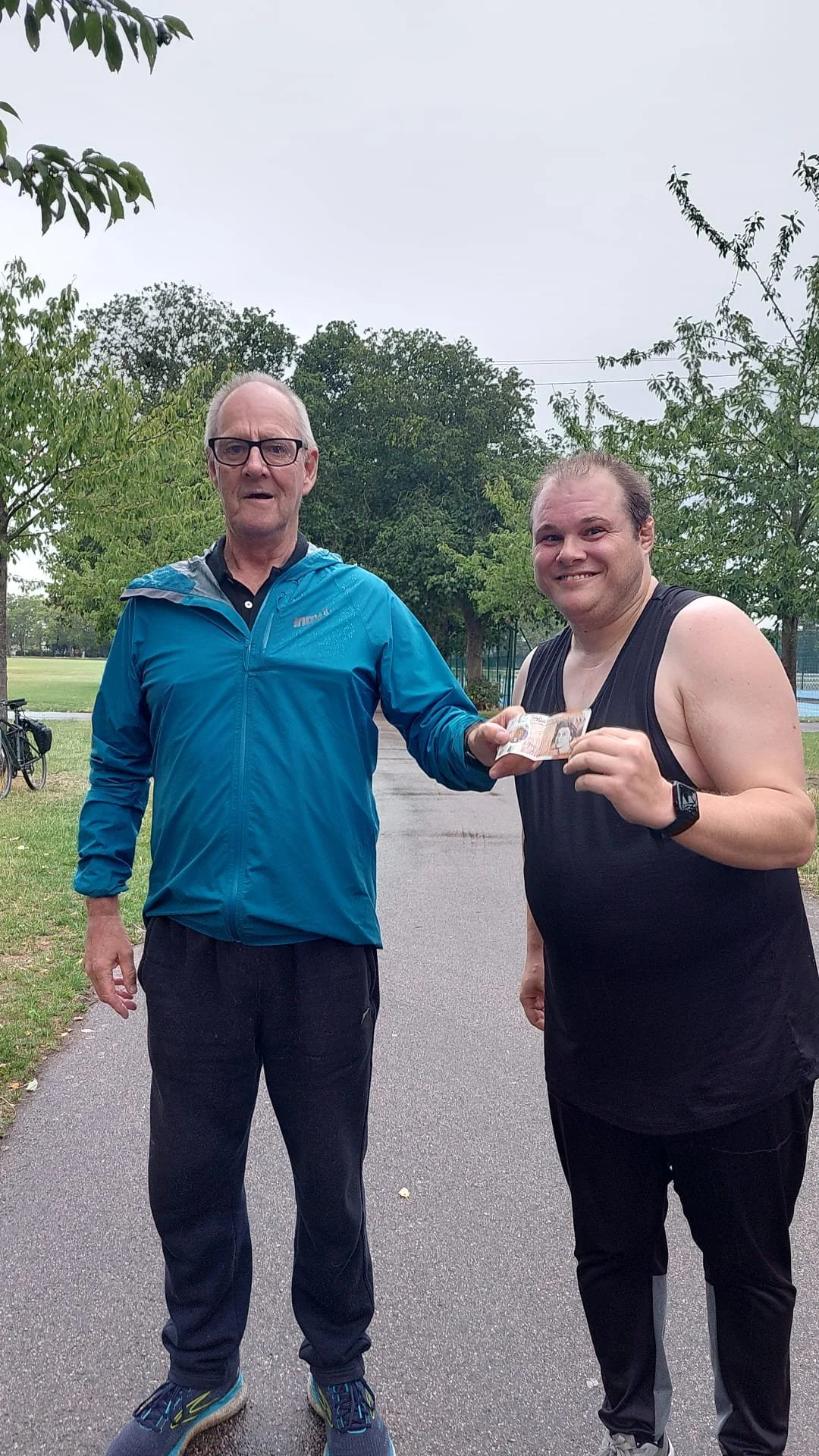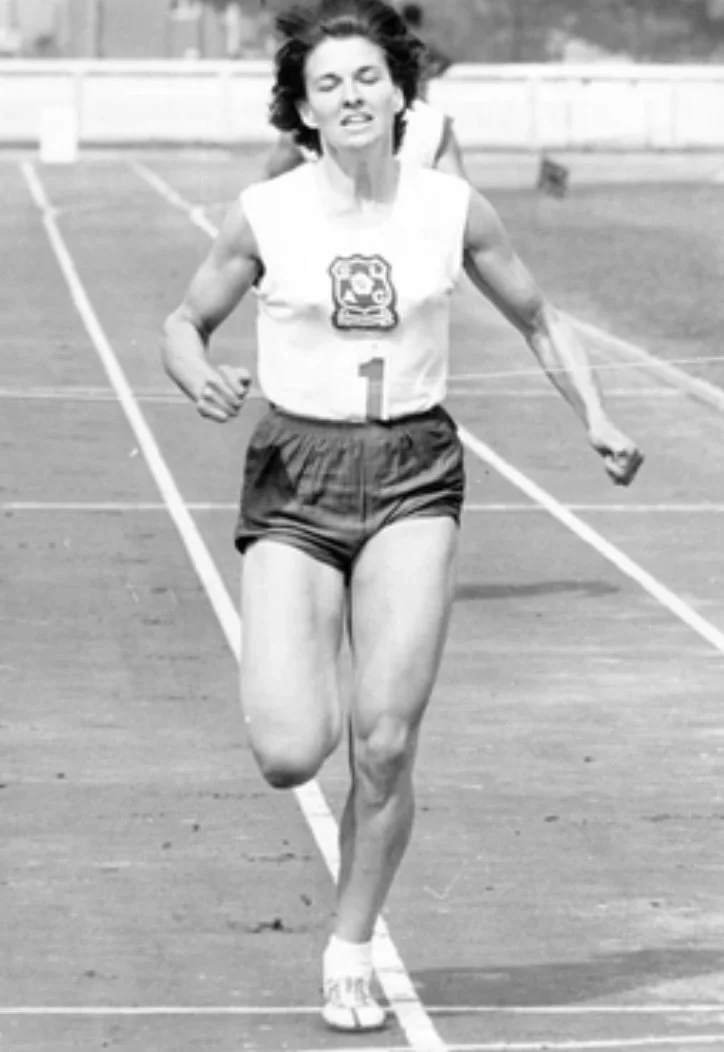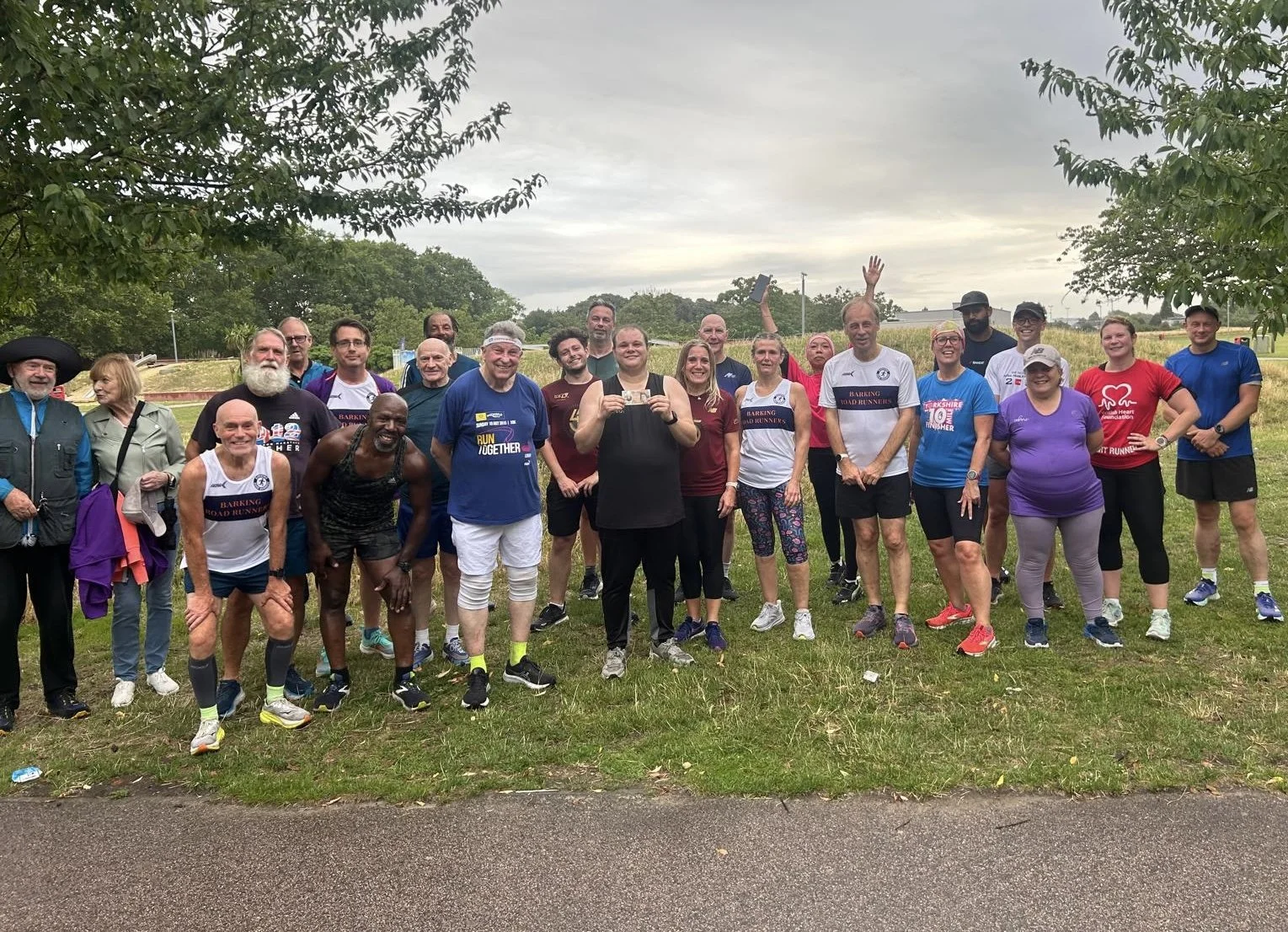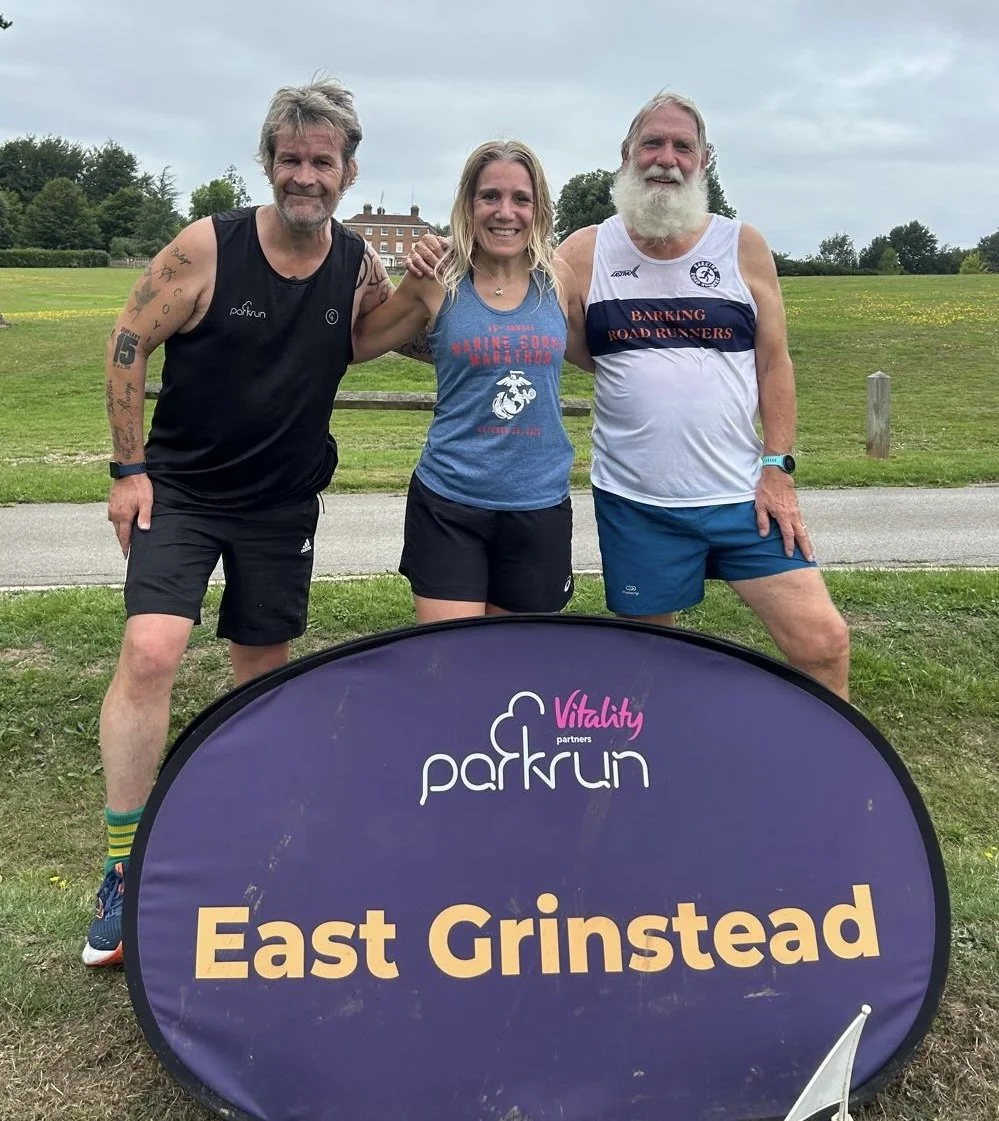BRR Blog – 28 July 2025
Handicap winner Darren collecting his prize from Greg
Hi there Road Runners!
The hot, dry weather we experienced over May and June has broken, and it even felt a bit autumnal a few days last week, which can only mean one thing: it must be the school holidays! Cooler, drizzly days are not great if you have kids to entertain for six weeks, but they are much nicer for running in - make most of it before the weather heats up again.
It's a busy week ahead, with an ELVIS race on Wednesday and again on Saturday. I know the latter will mean missing parkrun, but the Orion course through Epping Forest is very scenic, and it is always good to be part of the BRR team in an inter-club competition.
Committee Meeting - July
Please follow this link to the July Committee meeting minutes.
Poles Apart
Most of us have heard of the 80/20 method, where 80% of your weekly miles are easy, and 20% are hard. For example, if you run 20 miles a week, 16 miles should be easy, and 4 miles should be hard. Elite runners have used this method for years, spending most of their time at low intensity, with only a small amount at high intensity. Of course, their low intensity is often faster than some of our best efforts!
The 80/20 method is a form of polarised training. Polarised training means doing most of your workouts very easy and a small part at a hard effort, with little time spent at a moderate, middling, pace. The main idea is to make your easy runs truly easy so you can recover, and your hard runs truly hard to improve fitness.
Many runners run every day at a similar pace, often too hard to recover well, but not hard enough to improve. This can leave you tired and slow progress. With polarised training, you recover better and make bigger gains from your hard workouts. It also lowers your risk of injury by varying stress on your body.
You can think of polarised training in three zones
· Zone 1 (Easy): Easy, gentle pace. You can talk in full sentences. About 70-75% of your max heart rate.
· Zone 2 (Moderate): Breathing is harder, but you can still speak a little. About 80-85% of max heart rate. In pure polarized training, you spend little or no time here.
· Zone 3 (Hard): Very hard, can only say a few words. Above 85% of max heart rate.
While most polarised training plans recommend about 80% of time in Zone 1 and 20% in Zone 3, some plans use a different split, such as 70/30. But the key is to avoid spending much time in Zone 2.
Research shows polarised training can help you become faster and improve endurance more than just running every workout at a moderate pace. For example, one study2 compared the effects of a polarized training programme and a more traditional running training programme on 10K running performance over the course of ten weeks.
The researchers divided 30 endurance runners into two groups. The polarised training group did 77% of their mileage in zone 1 and 20% of the mileage was in Zone 3 (defined as high intensity above respiratory compensation threshold).
The “between thresholds endurance training” group ran 46% of their workout time in Zone 1, 35% in Zone 2, and 19% in Zone 3.
To quantify and qualify the type and duration spent in each training zone, runners wore heart rate monitors, and their exercise heart rates before and after the experiment were compared.
After ten weeks, both groups showed significant improvement in their 10K run times, but runners in the polarised training group improved their performance by 5%, whereas the other group improved by 3.6%. It doesn’t sound much difference, but it equated to the runners who had followed polarised training reduced their 10K run times by an additional 41 seconds compared to the other training group. That could make a big difference in a race or when aiming for a new PB.
Moreover, when the researchers examined which runners in the polarised training group had most dramatically polarized their training, they found that those with the least training time in Zone 2 experienced the most significant performance improvements.
If you find that you aren’t making the improvements you’d hoped for with your current training programme, it might be worth giving polarised training a go. The tricky bit will be keeping the easy days really easy – 70-75% of your max heart rate (roughly 220 minus your age) may feel like walking!
RIP Maeve Kyle OBE – the ‘Irish suffragette of athletics’
You may not have heard of her, but Maeve Kyle, Ireland's first female track and field Olympian at the 1956 Melbourne Games, has died at the age of 96.
Born in Kilkenny, Kyle started her sporting career playing hockey for Ireland, earning 58 caps before swapping to athletics.
Before the Melbourne, Ireland had only selected male teams for the Olympics. Kyle had to wait a further eight years, until the Tokyo Olympics, before her best event, the 400m, was an Olympic event for women. Kyle later reminisced
“In 1956 the only events for women were 100m, 200m, 80m hurdles, high and long jump, javelin, shot and discus – so nothing on the track over 200m.
“This was because men thought that women were not capable of running longer distances and that it wouldn’t be nice if they fell down and had to be resuscitated. I suspect that events like the hammer, triple jump and pole vault were thought to be not healthy for women, but I don’t think at that time there was any medical evidence to prove or disprove it.”
Strangely, Kyle found that it tended to older women, rather than men, who frowned upon her athletics career
“there was more opposition from, say, my mother’s age group than anyone else. They did not approve and I think I made them feel uncomfortable. I had the distinction of having a letter in the Irish Times saying what a disgraceful hussy I was going off to the Olympics, leaving my husband and small child behind. That shows you the attitude of certain sections of what was a very conservative society.”
Undaunted, Kyle continued to run and, in 1966 at the age of 37, she won her first major medal, a bronze in the 400m at the European Indoor Athletics Championships.
In her 40s she moved into coaching, alongside her husband, Sean, at the Ballymena & Antrim club which they had set up in 1955. She had the distinction of operating as manager for both Great Britain and Ireland teams and as a 71-year-old coached the Irish relay squads at the 2000 Sydney Olympics.
Summing up her career to Athletics Weekly in 2016, Kyle said “I have always reckoned that I was the Irish suffragette of athletics”.
On this Day in History…
Castelbuono, and its hill
27 July marked the 113th anniversary of the Giro Podistico Internazionale Castelbuono, one of the oldest road races in Europe.
First held in 1912, the race is run over 11.3k, made up of 10 laps (including an uphill section) around the historical centre of Castelbuono, a small town in northern Sicily. For this reason, it was originally called the “Maratonina dei 10 Giri” (little marathon of 10 laps). The first edition was won by Giovanni Blanchet, who completed the 10 laps in 51' 36”.
The race is a big deal in Italy and is broadcast on the national sports channel. In 2021 it was awarded the World Heritage Plaque, a recognition given by World Athletics for “exceptional contribution to the history and global development of sport, athletics, and non-stadium disciplines such as road running and walking, cross-country, mountain running, trail running, and ultra-marathons”.
Due to a few breaks in continuity, mainly due to the Second World War and the Covid Pandemic, the “Giro” will be celebrating its 100th edition in 2026. But don’t rush to register and book your flights to Sicily – it seems to be a closed race, open to invited male athletes only. There was a female race, but that only took place from 1995 to 2004. Perhaps they need a suffragette of athletics, like Maeve Kyle, to bring the race into modern times.
If at first you don’t succeed
Faith Kipyegon. Photo courtesy of Eric van Leeuwen
Faith Kipyegon’s attempt to be the first woman to break the four-minute mile failed recently. Martin Keino, who has paced several great runners to victory – including Haile Gebrselassie and Kenenisa Bekele - suggests there are seven reasons for this:
1. A Monumental Leap in Time – Faith’s best mile time to date, and a world record, is 4:07.64, so she would have had to run nearly eight seconds faster to go sub-four. For an elite athlete to trim that much time off a PB in one go is virtually unheard of. In the event, she clocked 4:06.42 in perfect conditions at Stade Charlety in Paris - 1.22 seconds faster than her world record.
2. Human Limits Are Real – Faith is an extraordinary athlete and can run 800m in 1:57.68. But to double that distance and break sub-four requires both speed and stamina. Perhaps it is just beyond her physiological ceiling
Faith’s speed is elite her 800m best of 1:57.68 proves it.
3. Pacing Isn’t Plug-and-Play – perfect pacing is an art, not an algorithm. Staying close behind a pacer at that kind of speed takes laser focus and resilience. Just losing contact for a second can scupper a record-breaking attempt, as the additional wind resistance starts draining energy.
4. Marginal Gains Make the Difference - Even the tiniest details can make the difference between success and failure. Pre-race routines, gear, timing of meals can tip the scale.
5. Training Has to Mirror the Goal – We all know the saying that if you want to race fast you need to train fast. To break sub-four means at least some of Faith’s training needs to be at sub-four pace, and in the same conditions.
6. Tech Helps but Only So Much - modern shoes and sleek running gear makes it much easier for today’s runners to push the limits than it was when Roger Bannister first broke the four-minute mile. But there is only so much it can do, particularly over 1609 metres., there’s only so much they can do.
7. Race Rust Is Real – Faith came into the attempt with just one race under her belt in 2025: a 1,000m effort. This might have meant that she was fresh for the record attempt. But it could also mean that she wasn’t quite as race-sharp as she might have been with more competitions under her belt. Also, the use of male pacers meant the record wouldn’t be officially recognized perhaps, which may have had an unconscious impact on Faith’s competitive spirit.
All this aside, you have to admire Kipyegon for even making the attempt. She might not have done it this time, but she could in the future. And, even if she doesn’t, I’ve no doubt that one day a woman will run a mile in less than four minutes. After all, they said a man could never do it and look what happened!
Greg’s Race Report
Participants at the handicap race
Race No 5 this week of the Barking Road Runners 5k Handicap race series at Barking Park. Twenty-one runners competed the race in good conditions as they managed to miss the rain and it wasn’t too hot, allowing seven runners to break their handicap which will mean a tougher start in race No 6. In a close finish Darren Graham held on for his first win from the fast-finishing Owen Wainhouse.
BRR parkrunners
Barking - James Lowndes 20:24, Owen Wainhouse 20:28, Joshua Ezissi 22:34, Jason Suddaby 23:39, Rosie Fforde 24:34, Tom Shorey 24:58, Stuart Burr 26:17, Sian Mansley 29:11, Joyce Golder 29:35, John Lang 29:41, Les Jay 38:55 and Alan Murphy 49:41.
Clacton Seafront - Rob Courtier 33:34 and Nikki Cranmer 35:14.
East Grinstead - Belinda Riches 29:36, Steve Colloff 33:02 and Dennis Spencer Perkins 33:25.
Steve, Belinda, and Dennis at East Grinstead parkrun
Eden Project - Jason Li 30:45.
Ingrebourne Hill - Mark New 24:45.
Mile End - Darren Graham 38:22 and Denise Graham 53:09.
Darren and Denise at Mile End parkrun
Raphaels - Doug King 27:11.
Richmond Park - John Mitchell 27:02.
Valentines - Kevin Wotton 24:43, Chandru Thayalan 25:42 and Andrew Gwilliam 37:31.
Wimpole Estate - Martin Brooks 28:51.
Highest BRR age gradings this week were Rosie Fforde 61.06% for the women and James Lowndes 70.02% for the men.
BRR Diary – July/August
The highlights of the coming weeks are listed below but you can see the full diary of BRR events on the TeamUp app. Simply download the TeamUp app to your phone, then enter the calendar key: ks67p21gt8p5gzdo66 when prompted. If you don’t want another app on your phone, you can also find it under the ‘events’ tab on the Barking Road Runners website: https://www.barkingroadrunners.org.uk/calendar.
7.00pm, Tuesday 29 July - Speed Session. Jim Peter’s Stadium, Mayesbrook Park. This week John Lang will be taking the session, and it’s ‘Catch the Coach’: everyone sets off round the track in one direction while John sets off in the other. As each runner passes John, they increase their pace and then decrease it when they pass him again. It’s a really fun way of doing fartlek.
7.30pm, Wednesday 30 July – Harold Wood 5k (ELVIS 06). Harold Wood Park, Harold View, Harold Wood, RM3 0LX. The race is run on a one-lap, multi-terrain, 5k course in and around Harold Wood Park and Pages Wood, Harold Wood. Online entries are now closed, but entries will be accepted on the day up to 6.30pm.
7.30pm, Thursday 31 July
10.30am, Saturday 2 August – Orion Forest 5 (ELVIS 06). Chingford Plain, Bury Road, Chingford (race HQ, Orion Clubhouse, Jubilee Retreat, further up Bury Road). A nice (though tough), cross-country, ELVIS race, usually with decent refreshments available at the clubhouse afterwards. Online entries open until 23:59 on 30 July: https://www.entrycentral.com/Orion_Forest_Five_Race_3_ELVIS
Cracker Corner
I went to the doctor's the other day and he told me my sugar was too high. I came home and moved it to a lower shelf.
I couldn’t believe my Dad was stealing from his job as a road worker, but when I went to visit him the signs were all there.
I was going to sign up for a yoga course, but it cost £100. I thought, ‘I can’t stretch to that.’
Quote of the Week
“Continuous effort - not strength or intelligence - is the key to unlocking our potential.”
Winston Churchill
And Finally…
A serious message this week: advance notice that the second-ever national test of the Emergency Alert system will take place on Sunday 7 September at around 3pm.
Since the first national test of the system in April 2023, Emergency Alerts have been to help protect communities during five genuine crises, including warning residents about an unexploded World War II bomb in Plymouth and providing critical safety information during localised flash flooding in Cumbria.
On 7 September at 3.00pm you should hear a loud siren sound lasting about 10 seconds from your mobile phone, even if it is on silent, with a message confirming that it is only a test.
I know some members got a bit agitated about this last time. Don’t worry, there will be a public awareness campaign nearer the time so you don’t have to remember.
Happy Running
Alison
Chair, Barking Road Runners






